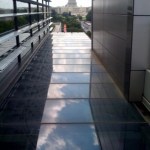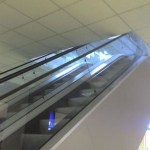engineering
Plastic Fantastic: How the Biggest Fraud in Physics Shook the Scientific World
by Eugenie Samuel Reich
New York: Palgrave Macmillan
2009
The scientific enterprise is built on trust and accountability. Scientists are accountable both to the world they are trying to describe and to their fellow scientists, with whom they are working to build a reliable body of knowledge. And, given the magnitude of the task, they must be able to trust the other scientists engaged in this knowledge-building activity.
When scientists commit fraud, they are breaking trust with their fellow scientists and…
I'm here in DC at the Newseum for the State of Innovation Summit, a collaboration between SEED and the Council on Competitiveness. The crowd is pretty awesome - right now Adam Bly, SEED's CEO, is sitting a few rows from me with E.O. Wilson. Earlier, Wayne Clough, Secretary of the Smithsonian Institution, talked about a conversation he'd had recently with Steven Chu about using the Smithsonian's resources to enhance public understanding of climate change. As he spoke, the intense sunshine of a summer day in DC played across the Smithsonian castle turrets directly behind him (the seventh floor…
tags: TEDTalks, biomimetics, biomutualism, biology, engineering, origin of flight, Robert Full, streaming video
Biologist Robert Full studies the amazing gecko, with its supersticky feet and tenacious climbing skill. But high-speed footage reveals that the gecko's tail harbors perhaps the most surprising talents of all. [12:27]
TEDTalks is a daily video podcast of the best talks and performances from the TED Conference, where the world's leading thinkers and doers give the talk of their lives in 18 minutes. Featured speakers have included Al Gore on climate change, Philippe Starck on…
Ok, that's a slight exaggeration. It isn't built yet.
But if York space scientists and engineers have anything to say about it, it sure will be.
Check it out from our internal newsletter, Space elevator designed at York University would reach 20 km above Earth:
"For decades, scientists have been grappling to find a more efficient means of getting payloads into space," says Brendan Quine (right), professor of space physics and engineering in York's Faculty of Science & Engineering, who is heading the project. A paper detailing the design was recently published in the journal Acta…
Some highlights from the IEEE's very fine Technology and Society Magazine, v29i2. You'll need a subscription to the magazine to access it on the IEEE's site.
Those in academic settings might want to especially take a look at Communication technology, emergency alerts, and campus safety.
Innovation as energy policy for the world [Policy Perspective] by Andrews, C.J.
Wireless nomad: Pioneer in an urban residential environment by Wong, M.A.
K-Net and Canadian Aboriginal communities by Fiser, A.; Clement, A.
Communication technology, emergency alerts, and campus safety by Gow, G.A.; Mcgee, T.;…
On Saturday, the Free-Ride family went to the Maker Faire.
The place was abuzz with things to do and see and hear (and taste and feel), so we'll just give you the snapshot.
There were fabulous arty and tech-y (and arty/tech-y) items on display, including a giant assembly of 2 liter soda bottles, spinning bike wheels onto which our drawings were projected in lights, and the obligatory giant Lego castle/cake thingy:
We also saw and heard a beautiful automated music-playing dealie created by Ranjit Bhatnagar, a friend of mine from geek camp years ago.
And, there was a cool Wimshurst machine (…
If you've been following the Jared Diamond/New Yorker controversy, or my ongoing posts on journalism vs. blogging (here, here, here, here, here), you might be intrigued by this conversation about the culture of fact-checking in journalism, between journalism professor Jay Rosen and programmer Dave Winer, in their podcast series Rebooting the News. Consider this riddle: how is fact-checking in journalism like (or unlike) debugging a computer program?
Here's Rosen's take on it:
One of the features of a rebooted news system would actually be borrowed from the tech world. And it's the notion of…
Lots of great articles in this issue! Pretty well every one is worth checking out:
Percentile-Based Journal Impact Factors: A Neglected Collection Development Metric by A. Ben Wagner, University at Buffalo
A Subject Librarian's Guide to Collaborating on e-Science Projects by Jeremy R. Garritano and Jake R. Carlson, Purdue University
What Engineering Sophomores Know and Would Like to Know About Engineering Information Sources and Access by Zorana Ercegovac, InfoEN Associates
The 2007 STS Continuing Education Survey: Continuing Education Needs of Science/Technology Librarians by Jo Ann…
I've mentioned before that I grew up in a family that was fairly captivated by the U.S. space program, especially the Apollo program that brought humans to the Moon. But as impressive as those manned missions to the Moon were, what did the Apollo program accomplish? Where are our moon-bases?
Orphans of Apollo, a documentary film by Michael Potter, explores what one group of space exploration enthusiasts did when NASA's commitment to the space age seemed to falter. By the mid-1970s, the Apollo program that put Americans on the moon was done, with two planned Apollo missions cancelled.…
Yesterday I was listening to Morning Edition on NPR and caught this very intriguing segment, Shakespeare Had Roses All Wrong. Would you describe a bridge as fragile, elegant, beautiful, peaceful, slender, pretty? Or as strong, dangerous, long, sturdy, big, towering? Lera Boroditsky, an assistant psychology professor at Stanford University, found that it depends - for native German and Spanish speakers, on whether your native tongue assigns a feminine or masculine gender to the noun bridge.
Boroditsky proposes that because the word for "bridge" in German -- die brucke -- is a feminine noun…
The American Scientist is the magazine of the scientific society, Sigma Xi. You can get it on the news stand, and that's where I bought the latest issue (March-April, 2009). One of the articles is by historian of engineering, Henry Petroski, and it's about the Tacoma Narrows Bridge. The bridge was a product of Depression infrastructure funding but instead of being an investment in the future it only lasted four months. It is famous because its spectacular collapse was caught on film (below the jump) and for many years was shown in thousands of undergraduate calculus and elementary physics…
Today is Ada Lovelace Day.
Regular readers of this blog may recall that I am a tremendous Luddite. Obviously, this should not be taken to mean I am against all technological advances across the board (as here I am, typing on a computer, preparing a post that will be published using blogging software on the internet). Rather, I am suspicious of technological advances that seem to arise without much thought about how they influence the experience of the humans interacting with them, and of "improvements" that would require me to sink a bunch of time into learning new commands or operating…
Eight choices for the best example of a design flaw.
#2
#3
#4
#5
#6
#7
#8
These were forwarded to me by a colleague, who had them forwarded to her by a friend, who, guess what, had them forwarded from somewhere else. I thus do not know their origin. The pictures are either (a) legitimate, (b) fabricated, or (c) doctored versions of legitimate things. I don't know.
Wired for War: The Robotics Revolution and Conflict in the 21st Century
by P.W. Singer
New York: Penguin
2009
For some reason, collectively humans seem to have a hard time seeing around corners to anticipate the shape our future will take. Of those of us who remember email as a newish thing, I suspect most of us had no idea how much of our waking lives would come to be consumed by it. And surely I am not the only one who attended a lab meeting in which a visiting scholar mentioned a speculative project to build something called the World Wide Web and wondered aloud whether anything would…
You may remember that last year we were inspired by Bake for a Change to dabble in "green" gingerbread construction. As 2008 draws to a close, the challenge has been issued once again to make a house both good enough to eat and eco-friendly enough to heat (or cool, etc.).
The rules are the same as they were last year:
1) Everything must be edible.
2) However half-baked (har har), there must be at least FOUR identifiable sustainable building design elements.
3) Your design must include a minimum of a floor, a door, four walls, a roof, and two windows.
This year our effort resulted in a…
Earthquake engineer Kit Miyamoto has posted a journal of his trip to Sichuan. If you don't mind a little bit of construction jargon it's a good discussion of the details of what kinds of buildings collapse, and what kinds are safe, as well as the logistical difficulties of the immediate post-earthquake recovery. The lesson to be learned from the Sichuan earthquake is the same as the lesson of basically every major earthquake in the past several decades: If you build bad buildings, they will fall down and kill people.
After some earthquakes, we have been able to dramatically improve our…
Once again, I'm teaching the relatively new ethics module in "Introduction to Engineering". Today was the discussion of what kinds of ethics might reasonably govern an engineering student's behavior, and how these might be important on the road to becoming a competent grown-up engineer.
So of course, we talked about cheating.
The students in the course all have i-Clickers, which means I can ask them questions and have them indicate one of up to five multiple-choice answers, then look at the results immediately and discuss them. In one of the sections I taught today, a majority of the…
Speaking of science fairs, if you know of kids (grades 5-12) in the San Francisco Bay Area who are looking for a challenge, this one might be of interest:
It is not too late to participate in this year's Tech Challenge. The Tech Museum of Innovation's 21st annual Tech Challenge is designed to get at the heart of innovation for young people and is geared to the California Math, Science and Language Arts standards. This year's Tech Challenge focus is on the need for safe clean drinking water. One in five people in the world do not have regular access to safe drinking water. The challenge:…
tags: robofly, microrobotic fly, engineering, biobot, nanotechnology, streaming video
Robotics researchers have long been envious of flying insects, many of which are able to perform all sorts of spectacular acrobatics despite their small wings and smaller brains. Researchers at Harvard University created a robotic fly the size of a penny that is actually able to fly using a wing structure and motions based on a fly. The robofly weighs 60 milligrams (the equivalent of a few grains of rice), and beats its 1.5cm wings 120 (!) times per second. Most impressively, the actuating composite motor…
As I mentioned earlier, the sprogs and I decided to try our hands at building an entry for the contest to build a gingerbread house using sustainable building design practices. We read up on principles of sustainable design and stocked up on unsulfured molasses and powdered sugar.
Here's what we did and what we learned.
Every engineering project involves working within constraints. For starters, there are the contest rules:
Everything must be edible.
However half-baked (har har), there must be at least FOUR identifiable sustainable building design elements.
Your design must include a…

